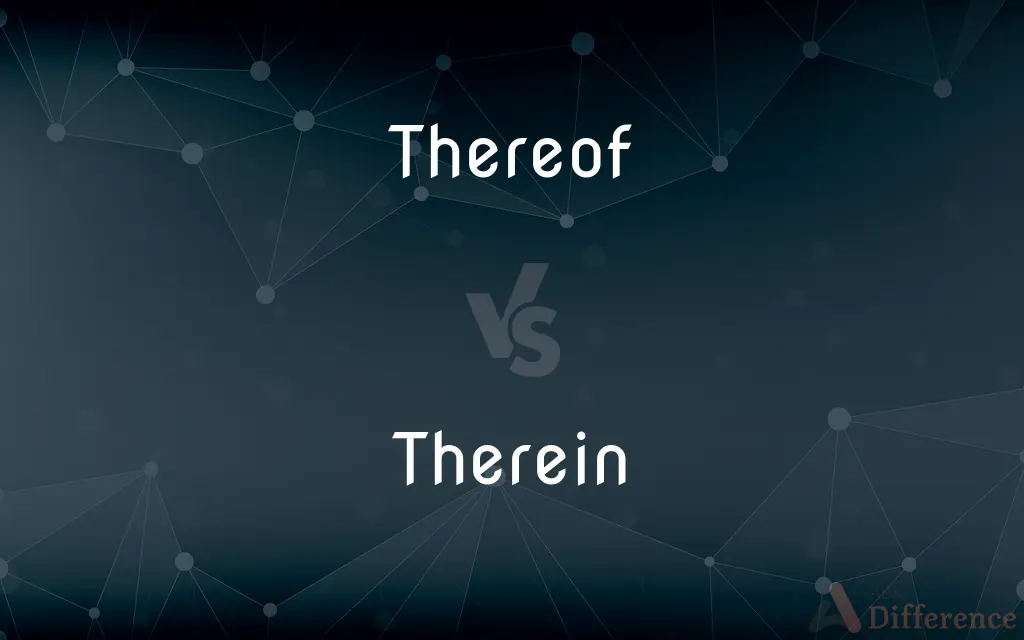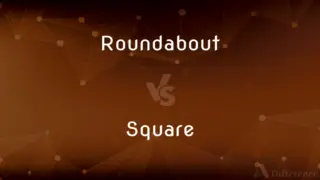Thereof vs. Therein — What's the Difference?
By Tayyaba Rehman & Maham Liaqat — Updated on March 14, 2024
"Thereof" refers to something previously mentioned, indicating possession or relation, while "therein" points to something contained within something else, highlighting location.

Difference Between Thereof and Therein
Table of Contents
ADVERTISEMENT
Key Differences
"Thereof" is a term used to refer to something that was mentioned earlier in a text, emphasizing a relationship or belonging to something. It often appears in legal, formal, or written contexts to specify aspects or elements of the subject under discussion. Whereas "therein" is used to indicate the presence of something within a particular place or thing. It suggests that what is being referred to is located inside or within the boundaries of something previously mentioned.
In legal documents, "thereof" is frequently used to refer back to a particular part of the document itself, helping to avoid repetition and maintain clarity. On the other hand, "therein" is used to point out specific information or elements that are contained within a document or a specific section of it, often to highlight location or context within a broader topic.
The usage of "thereof" can often be seen in descriptions of rights, obligations, or properties, linking them back to the subjects or objects they belong to. This helps in specifying the scope or extent of what is being discussed. Whereas "therein" tends to be more about the inclusion or presence of items, details, or facts within a physical or metaphorical space, enhancing the detail of the description or narrative.
"Thereof" carries a sense of external relation or attachment to something, implying a connection or result arising out of a previously mentioned subject. It helps in constructing sentences that convey a sense of derivation or source. On the other hand, "therein" focuses on internal presence, emphasizing what lies within the confines of something, which can be a document, area, or concept, thereby drawing attention to its contents rather than its relationships.
In terms of syntactic function, "thereof" acts as a pronoun that replaces a prepositional phrase, thereby avoiding repetition and making sentences more concise. Whereas "therein" similarly replaces phrases like "in that" or "inside it," it serves to streamline communication by pointing to a location or context within a previously mentioned framework without needing to reiterate the noun.
ADVERTISEMENT
Comparison Chart
Definition
Refers to something mentioned before, indicating possession or relation.
Indicates something contained within something else, highlighting location.
Context of Use
Often legal, formal, or written texts.
Common in legal, literary, or formal texts.
Function in Sentence
Specifies aspects or elements related to a previously mentioned subject.
Points out specific information or elements within a particular place or thing.
Implication
Suggests ownership, attachment, or derivation.
Suggests inclusion or presence within boundaries.
Example of Use
The owner of the book and the rights thereof.
The treasure hidden therein was never found."
Compare with Definitions
Thereof
Relating to something that has just been mentioned.
He mentioned the painting, and the origin thereof.
Therein
In that place, document, or respect.
The clause mentioned therein was crucial.
Thereof
Expressing a relation or belonging.
The document outlined the responsibilities thereof.
Therein
Concerning that matter, case, or point.
The evidence therein supports the argument.
Thereof
Indicating part of a whole.
They took the whole pie, leaving none thereof for us.
Therein
Referring to the content of something.
The magic described therein fascinated them.
Thereof
Specifying a particular element or aspect.
The terms of the agreement, and the breach thereof, were clear.
Therein
Within the confines of something.
Secrets hidden therein were eventually revealed.
Thereof
Pertaining to a subject or object previously discussed.
The consequences thereof were severe.
Therein
Inside or within a particular area or space.
They found solace therein.
Thereof
Of or concerning this, that, or it.
Therein
In that place, time, or thing.
Thereof
From that cause or origin; therefrom.
Therein
In that circumstance or respect.
Thereof
Of this, that, or it.
Therein
(pronominal) in that; in that place; in him/her/it.
Thereof
From that circumstance or origin; therefrom, thence.
Therein
In that or this place, time, or thing; in that particular or respect.
He pricketh through a fair forest,Therein is many a wild beast.
Bring forth abundantly in the earth, and multiply therein.
Therein our letters do not well agree.
Thereof
Of that or this.
In the day that thou eatest thereof, thou shalt surely die.
Therein
(formal) in or into that thing or place;
They can read therein what our plans are
Thereof
Of or concerning this or that;
A problem and the solution thereof
Thereof
From that circumstance or source;
Atomic formulas and all compounds thence constructible
A natural conclusion follows thence
Public interest and a policy deriving therefrom
Typhus fever results therefrom
Common Curiosities
How do "thereof" and "therein" differ in function?
"Thereof" specifies aspects or elements related to something mentioned, whereas "therein" highlights specific information or elements within something.
Where are "thereof" and "therein" commonly found?
Both are commonly found in legal, formal, or written texts, though their usage varies according to the context.
Is "therein" considered formal?
Yes, it is considered formal and is used in contexts requiring precision, like legal documents.
What does "thereof" mean?
It means relating to or belonging to something previously mentioned.
Can "thereof" indicate a part of something?
Yes, it can indicate a part or aspect of something that has been mentioned.
Are "thereof" and "therein" easy to use for English learners?
They can be challenging due to their formal nature and specific contexts of use.
How is "therein" used in a sentence?
It is used to indicate that something is contained or exists within a certain place or document.
Can "thereof" and "therein" be used interchangeably?
No, they serve different purposes; "thereof" refers to possession or relation, while "therein" points to location or presence within something.
Does "therein" imply physical location only?
No, it can imply both physical and metaphorical locations, including documents or narratives.
Is "thereof" still used in modern English?
Yes, it is used, especially in legal and formal contexts, to denote relation or belonging.
What is the implication of using "therein" in a description?
It emphasizes the inclusion or presence of something within a defined space or context.
What is a common use of "thereof" in legal documents?
It is used to refer back to specific elements or conditions mentioned in a document.
How do "thereof" and "therein" enhance written communication?
They provide concise and precise ways to refer back to previously mentioned subjects or to specify location and contents, enhancing clarity and coherence.
Can "therein" be used to refer to information in a document?
Yes, it often refers to specific details or content within a document.
What is the syntactic role of "thereof" in a sentence?
It acts as a pronoun replacing a prepositional phrase, linking back to a previously mentioned noun.
Share Your Discovery

Previous Comparison
Shabbos vs. Shabbat
Next Comparison
Roundabout vs. SquareAuthor Spotlight
Written by
Tayyaba RehmanTayyaba Rehman is a distinguished writer, currently serving as a primary contributor to askdifference.com. As a researcher in semantics and etymology, Tayyaba's passion for the complexity of languages and their distinctions has found a perfect home on the platform. Tayyaba delves into the intricacies of language, distinguishing between commonly confused words and phrases, thereby providing clarity for readers worldwide.
Co-written by
Maham Liaqat













































